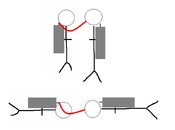I'd like to get your thoughts and advice on air sharing during ascent. Let me start by explaining where I'm coming from.
This weekend my wife and I decided to do some skills practicing at the local quarry. We wanted to look at some basic trim issues etc. but also to do air sharing while doing a free ascent with a 3 minute safety stop at 5m.
What a disaster! We started our free ascent at 15m and as soon as my wife took my octo, she became a cork. I'm sure it has nothing to do with using my octo but just that she forgot to mind her buoyancy. I grabbed her by the fin and pulled her down and at the same time dumped all the air from my BC. We must have been at around 10m by the time our upwards movement stopped and I'm surprised that our computers didn't complain of ascent rate violations so it couldn't have been too bad. By now she's realised what happened and she dumped all her air as well and before we knew it, we were back to 15m.
After some heavy finning and air additions to the BC's our buoyancy was sorted. OK, so we started the intended ascent. Things seemed fine although I think it could have been better. We didn't really ascend steadily but rather bobbed up and down with a net upwards movement, probably not ideal but not catastrophic either. The same thing continued through the safety stop and our 3 minute stop constantly varied between 4m and 6m.
If this was a real life emergency I think we'd have survived, even without harm. However, in a real life emergency at least one diver will probably have been much more panicked and things could have been much worse so I think we'll go back and practice this again until we get it right.
Now, your help and advice please.
1. Throughout the exercise, we were in the vertical position. Sorting out our bad buoyancy would probably have been easier if were horizontal but in a real life emergency I'm pretty sure at least one diver will not remain horizontal. Your thoughts? What is a good position for an air sharing ascent?
2. Keeping on the topic of body position, I found that donating an octo made things pretty tricky. We had planned on grabbing each other's BC's with the one hand, facing each other but the awkward looping of the octo hose made that, well, awkward. So we ended up being almost side by side, her to my left. Again, what is the correct way?
3. Both of us kept a close eye on our computers throughout, mostly to keep a tab on our depth. We both had the same computer but even so, they didn't give he exact same readings all the time. So while she thought we we're at 5.4m, I thought we were at 4.6m (this is probably because of the 20sec sample interval). The thing is I'd be trying to get us deeper while she'd be trying to get us shallower or vice versa. Would it perhaps be a better idea for both of us to keep an eye on just one of the computers?
4. Would it not perhaps be a good idea for only one of the two divers (the one who is not OOA, ie. the donating diver) to manage the entire ascent? In other words, the receiving diver has only two tasks, keep the donated octo in your mouth and hold on to the donating diver's BC. The donating diver then makes sure the collective buoyancy is correct and manages the safety stop, monitors the computer etc.
What else can you gurus tell me? I think this might be a valuable skill to master and once we have this one down pat we'll move on to buddy breathing during free ascent with a safety stop.






